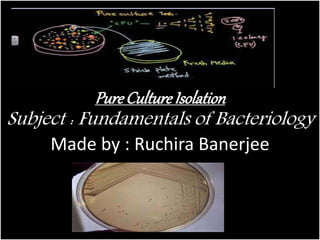
pure culture isolation
- 1. PureCultureIsolation Subject : Fundamentals of Bacteriology Made by : Ruchira Banerjee
- 2. Introduction • Bacteria exist is nature in mixed forms • To study every species independently, it is necessary to obtain their pure culture • The two major steps of obtaining a pure culture are as follows : Firstly, the culture has to be diluted until the various individual microorganisms are separated far apart on agar surface that after incubation they form visible colonies isolated from the colonies of other microorganisms. This plate is called an isolation plate Secondly, an isolated colony has to be aseptically picked off the isolation plate
- 3. • Points to be taken into consideration during the inoculation are : The inoculation loop has to be sterilized before every inoculation of colonies from the agar plate Every time the loop is sterilized by heat it must be cooled before inoculating the next colony • There are several methods of isolating the pure culture of bacteria, like, streak plate method, pour plate method, spread plate method and serial dilution
- 4. StreakPlateMethod • The most common technique of isolation of bacterial cells on the surface of agar plate is the streaking method • It is a simple and a rapid way of isolating cells of bacteria on the agar plate surface through mechanical means • As the loop is streaked on the agar surface the bacterial cells are rubbed off until individual separate organisms are deposited on the agar
- 5. • After incubation the area at the beginning of the streaking will show confluent growth of bacterial cells, whereas, the area at the end of the streak will show discrete colonies of bacterial cells
- 6. Pourplatemethod • This method is used to count the number of colony making bacteria in liquid specimen • In this method a fixed amount of inoculum is taken from a broth or say sample is placed in the centre of a sterile Petri plate with the help of a sterile pipette • Molten cooled agar is then poured into the Petri plate containing inoculum and mixed well • After the solidification of the Agar the Petri plate is inverted and incubated at 37degree C for 24-48 hours
- 7. • Bacteria will grow both on the surface and within the media. • Colonies which grow within the medium are very small in size and may be confluent • Few bacteria which grow on the agar plate surface are of same size, and appear as those on a streak plate
- 8. Spread plate method • This technique is used to readily quantify the amount of bacteria present in a solution • In this technique, the sample is diluted and then a little amount of it is added to the agar plate • Then the sample is spread over the agar surface evenly with the help of a spreader • After the colonies grow, the number of colonies is counted and the original number of bacteria in the sample is counted • The end point of our analysis is the number of colony forming units per milliliters
- 10. Serial dilution • It is a method of stepwise dilution of a substance • The dilution factor is kept constant, resulting in the geometric progression of concentration in a logarithmic fashion • Each dilution reduces the concentration of bacteria by a specific amount • By calculating the total dilution over the entire series, it is possible to know how many bacteria were present when the process was started